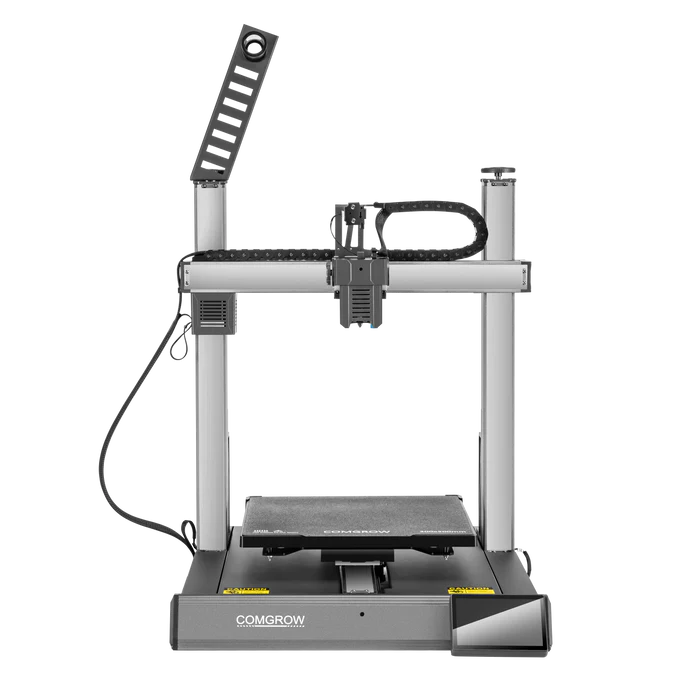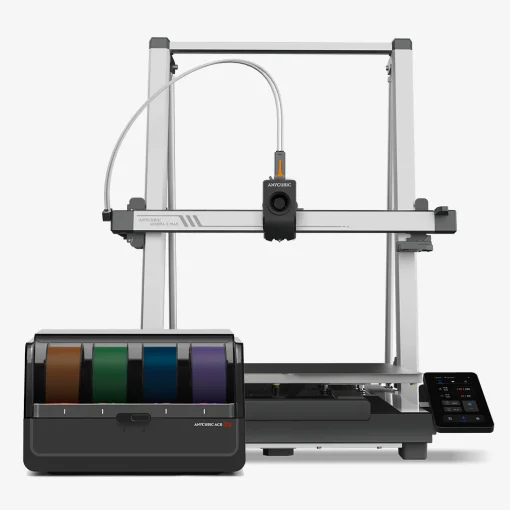Compare Comgrow T300 vs Kobra 3 Max Combo
Comparison between the best 3D printers
Choose the best 3D printer at the best price. The cheapest 3D printers are here.
Buy a 3D printer here with 3D Fila.
 |
 |
|
| Model | Comgrow T300 |
Kobra 3 Max Combo |
| Printing Material | Filament | Filament |
| Buy Filament for Sovol Comgrow T300 | Buy Filament forAnycubic Kobra 3 Max Combo | |
| Estimated price | $449,00 | $699,00 |
| Manufacturer | Sovol | Anycubic |
| Release Year | 2024 | 2025 |
| Print Volume [mm] | 300x300x350 | 420x420x500 |
| Printer Size [mm] | 503x631x831 | 640x753x706 |
| Weight [kg] | 17 | 23,6 |
| Power Loss Recovery | YES | YES |
| Enclosed printer | NO | NO |
| Bed Leveling | Automatic | Automatic |
| Filament End Sensor | YES | YES |
| Bed type | Heated | Heated |
| Power supply system | Direct Drive | Bowden |
| Standard nozzle | 0,4 | 0,4 |
| Maximum Nozzle Temperature [°C] | 300 | 300 |
| Maximum Bed Temperature [°C] | 100 | 90 |
| Maximum printing speed [mm/s] | 600 | 600 |
| Filament holder | YES | YES |
| Camera for supervision | NO | NO |
| Recommended filaments | PLA, PETG, PET, TPU, PA, ASA, PC, PLA CE, PA-CF, PET-CF | PLA, PETG, TPU |
| Recommended slicers | Bambu Studio, Super Slicer, Cura, Prusa Slicer, Orca Slicer | Anycubic Slicer, Cura, Orca Slicer |
| Maximum Resolution [mm] | 0,1 | 0,01 |
| Processor | 64 bit | |
| Display | Touchscreen 5'' | Touchscreen 4,3'' |
| Power Supply | 150 W | 800 W |
| Connectivity | USB, WiFi | USB, Wifi |
| Operating systems | Windows, Linux, Macbook | Windows, Mac, Linux |
| Date of registration in the system | 2024-05-10 | 2025-03-06 |
| Release date | 2024 | 2025 |
| Extra features | The Sovol Comgrow T300 printer stands out for its technological innovations and advanced features. With a print size of 300mm300mm350mm, the T300 offers true linear rails on all axes, ensuring greater stability. Its Klipper-based intelligent core and 64-bit microcomputer increase printing speed and quality through pressure advancement and input shaping. The extruder with a gear ratio of 6.5:1 allows for more precise material control, optimizing the printing of flexible materials. In addition, the T300 features a rapid filament cooling system with a high-speed fan and a circular duct piece that improves cooling efficiency. With a 4.3-inch high-refresh rate touchscreen and an 81-point automatic leveling system, the T300 simplifies the preparation and execution of 3D prints. | The Anycubic Kobra 3 Max Combo combines high-speed and multicolor printing with up to 8 colors. It features automatic leveling, quick filament switching, clog and entanglement detection, and AI to prevent print failures. Its 800W hotbed heats up quickly, while 10,000mm/s² acceleration ensures efficiency. App and Wi-Fi control, print recovery, and video monitoring enhance the user experience. |
| Support for multiple colors and materials (AMS and CFS) | NO | YES |
Notes * |
||
| Cost-benefit | 8 / 10 | 7 / 10 |
| Hardware | 3.6 / 10 | 6 / 10 |
| Tela | . | . |
| Print volume | 4 / 10 | 4 / 10 |
| Performance | 5 / 10 | 5 / 10 |
Conclusion |
| In comparing the Comgrow T300 and the Kobra 3 Max Combo, both 3D printers demonstrate distinct advantages tailored to different user needs. The Comgrow T300 emerges as a more cost-effective choice, appealing to users who prioritize affordability while still benefiting from modern features such as automatic bed leveling, a high-refresh touchscreen, and enhanced stability from its linear rails. Its efficient design facilitates the printing of a wide range of filaments, making it versatile for various projects. On the other hand, the Anycubic Kobra 3 Max Combo is positioned as a premium option that elevates the printing experience with its ability to handle multicolor prints and a more advanced AI system designed to reduce print failures. Although it comes at a higher price point, its features like quick heating times and enhanced control capabilities may justify the investment for users seeking higher efficiency and more complex printing tasks. In summary, the Comgrow T300 is ideal for budget-conscious users looking for solid performance without breaking the bank, whereas the Kobra 3 Max Combo caters to those who are willing to invest more for advanced features and capability, particularly in multicolor printing. Ultimately, the choice between the two models will come down to a user’s specific needs, preferences, and budget. |

